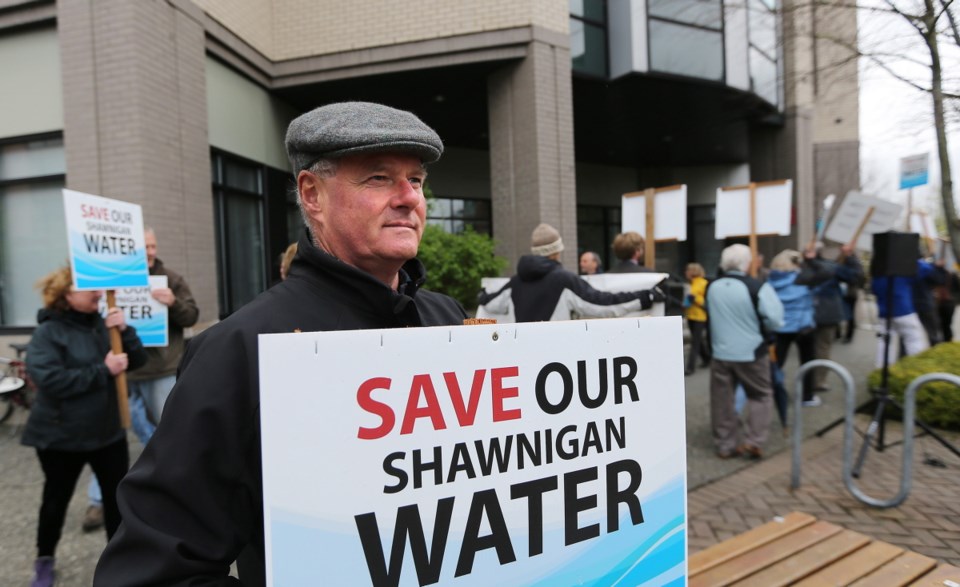Capital Regional District directors have added their voices to the chorus calling on the province to block the permit for a contaminated soil dump at Shawnigan Lake.
On Wednesday, directors endorsed a motion by Victoria Coun. Ben Isitt to support the Cowichan Valley Regional District’s request that the province deny South Island Aggregates a waste discharge permit in light of inadequate public consultation and conflicting hydrological and technical opinions.
The resolution also called on the province to amend contaminated site regulations and the permitting process to allow for “thorough and appropriate” consideration of local government input and land-use regulations.
Only Oak Bay Mayor Nils Jensen voted against the motion, saying the 24-member board was being asked to take a public-interest advocacy position — something that is outside the CRD’s jurisdiction.
The Environment Ministry has issued a draft permit for South Island Aggregates’ application to use its quarry at 460 Stebbings Rd. in Shawnigan Lake as a dumping ground for 100,000 tonnes of contaminated soil a year — much of it from the Greater Victoria area — for the next 50 years.
The public comment period ended this week, and Environment Minister Terry Lake has said the decision on whether to issue a permit will be made by a ministry regional director, based on the technical judgment of staff.
Shawnigan residents, who fear their water source could be contaminated, demonstrated outside the Environment Ministry’s Jutland Road offices before Wednesday’s CRD meeting.
Demonstrators chanted “Hey, hey Terry Lake, keep your hands off our lake,” and “We are not Victoria’s toilet,” as they marched in front of the offices.
“It’s important for them to realize we are not going away,” said Bruce Fraser, Shawnigan’s CVRD representative. “We’re trying to recruit the assistance of people worried about the Victoria watershed.”
Isitt said regions should be dealing with their own contaminated waste.
“We have to insist that the development industry here in Victoria takes full responsibility for disposing of [contaminated] waste in the most environmentally sensitive way,” he said.
The City of Victoria is putting contaminated soil from the Johnson Street Bridge project in a berm, Isitt said.
“There may be additional costs, but that’s the most responsible way to proceed. That soil should be processed here.”
About 30 people squeezed into the CRD boardroom and half a dozen — including CVRD director Gerry Giles — called on CRD directors to join their Cowichan Valley counterparts in opposition to the permit.
“It’s the definition of insanity: contaminated soil in a watershed,” said Shelagh Bell-Irving, a Shawnigan Lake resident.
A report commissioned by residents says if Shawnigan Lake was polluted by the toxic soil, the contamination could spread through aquifers to Greater Victoria’s Sooke Lake watershed.
South Island Aggregates, which has largely remained silent throughout the application process, this week released a statement through its engineering company, Active Earth Engineering, saying that much “incorrect, false and misleading information” has been circulated about their application.
“One significant inaccuracy is the assertion that limestone deposits are pervasive below the site and somehow connect the site to local bedrock aquifers, Shawnigan Lake and the CRD watershed,” the statement says.
The quarry is not a limestone quarry and, in fact 75 metres of “competent bedrock” separates the base of the pit from the underlying aquifer.
“The proposed facility would only accept non-leachable contaminated soil — a solid waste. No liquid wastes would be accepted. No leachable contaminants would be accepted,” the statement reads.
Ted Robbins, the CRD’s general manager of integrated water services, said it seemed unlikely the South Island Aggregates facility would affect capital region water.
“We are not aware of the extensive limestone deposits that have been identified, which are considered to be the source of subsurface groundwater movements,” Robbins said.
“At this point, based on what we know, we don’t consider this to be a high risk to the Sooke Lake reservoir.”
CRD directors asked staff to provide an internal analysis of available information on any potential impacts the South Island Aggregates facility could have on the region’s water.



